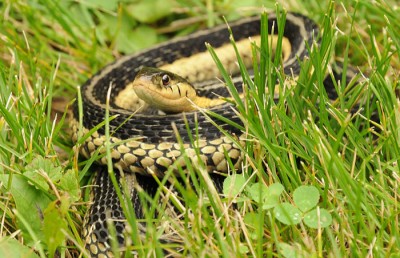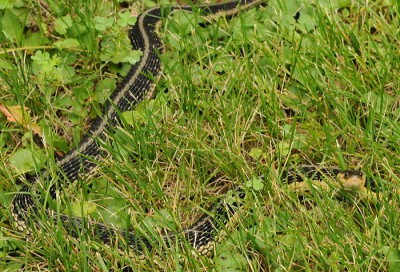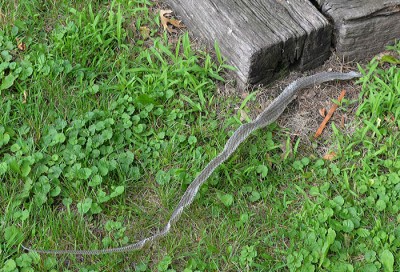Snakes Are Easier to Respect Than Love
Patrick Durkin 07.24.14

In all likelihood, I nearly stepped on the big garter snake while carrying my load of birdseed to our feeders during a recent lunch break.
I just didn’t notice the snake until returning minutes later. As I rounded the southeastern corner of our Wisconsin home, I suddenly halted as if spotting a land mine in our lawn. There it lay, coiled in the midday sun, stirring slightly as it sensed I wasn’t just passing by again.
After the split-second needed to identify the serpent as a common garter snake—our state’s most abundant and widespread snake—I relaxed and studied it more closely to locate its narrow head. My curiosity satisfied, I returned to the garage to drop off my buckets and feed scoop, my thoughts already returning to tardy work festering in my basement office.

I mean, who frets about a garter snake? They’re not venomous and they’re only slightly less common in our yard than roaming cats. Still, I couldn’t focus on my work. Not yet anyway. I know someone who cares a lot about any and all snakes in our yard and small woods: my wife, Penny. If she had her way, I’d catch every snake I see, tie it inside a gunnysack, and give it a free ride to the next county before releasing it.
But that’s a waste of time and gasoline. Unlike most “problems,” garter snakes usually go away on their own. Oh, I’m sure they don’t go far, but if you leave them alone, they typically slither away and you soon forget about them until your next encounter. It’s not like they wait for you near the door and then race ahead to catch your attention, or intentionally get in your way as you do lawn and garden chores.
Besides, I used to provide catch-and-release services for garter snakes during our early years of marriage, and never detected a difference in snake sightings. Nature abhors a vacuum, it’s said, and every time I moved one or three snakes to different locales, others soon took their place. That’s probably because our homes have always had shrubs and thick flower beds growing alongside their foundations, as well as rock walls or border-defining railroad ties laid end to end.
That’s all ideal habitat for small frogs, toads, crickets, grasshoppers, worms, and other snake prey. Unless we planned to sterilize the space around our home by removing all those plants, shrubbery, rocks, and other cover, we’d always provide good living quarters for snakes and their food.
So, in this latest case, I again chose the easy solution: I simply wouldn’t tell Penny about the garter snake, just as I hadn’t told her about seeing it the previous two lunch hours.

Then another thought occurred: I didn’t have any good garter-snake photos on file, and this snake was resting in a well-lighted spot, practically inviting me to photograph it. I hurried downstairs to retrieve my camera, hoping the snake would stay put long enough for a photo session.
It did. As I approached its resting site, I spotted its black coils in the grass, and yellow stripes catching just enough sun to stand out against the greenery. Again I followed its curves until locating its thin head, and noticed its round eyes focused on me, its head moving slightly to track my movements as I photographed it from different angles.
Next I kneeled about six feet away to shoot photos from head on, inching closer every few photos in hopes of getting extreme close-ups. As my telephoto lens crept closer and closer, the snake’s tongue flicked in and out, perhaps nervously. Contrary to what some folks claim, the snake’s forked tongue isn’t a stinger. It’s a sensory organ, not only for taste, but also to help decipher smells and sounds.
Eventually the snake grew bored with me and moved toward the railroad ties between our yard, flower beds, and house. It paused as its head crested a heavy oak tie, and then slithered into hiding.
The photos were good enough that I felt compelled to share them on Facebook with family and friends, thus alerting Penny about the snake’s presence. I assured her the snake wouldn’t bother her, and showed her where I’d seen it. Then, just as we turned to walk back inside, I paused and said, “Huh!”
“What? Do you see it?”

“Nope. But it was here.”
There by a different railroad tie was the snake’s shed skin, clearly fresh and perfectly intact from the tip of its thin tail to the point of its rounded nose. Once again I turned to go inside for my camera. Although we often pull snakeskins from woodpiles at our friend Tom Heberlein’s shack in Ashland County, I’d never thought to photograph them. This was too high-quality of a snakeskin not to seize the photo opportunity.
Penny didn’t follow me, however. She walked all the way around the house in the opposite direction to avoid seeing the skin. Now, some unsympathetic types might wish that her detour unintentionally led her to the snake’s latest resting site, but it didn’t.
And I didn’t wish that to happen. As I’ve mentioned in previous columns, I’m not comfortable with snakes either. Sure, I’ve often handled garter snakes, and I’ve twice rescued big eastern hognose snakes from landscape netting, but only because I didn’t want to kill them or see them suffer.
But please don’t try to convince me that people will lose their fear of snakes once they’re educated about snakes’ many benefits. I appreciate that garter snakes eat crickets, grasshoppers, June bugs, and other irritating insects, but my heart leaps and my spine chills every time a snake startles me.
I don’t think that’s a learned behavior. I think it’s hard-wired deep inside. We might learn to cope with our reactions, but I doubt we’ll ever abolish them through “education.”
Tolerance and appreciation will have to suffice.

